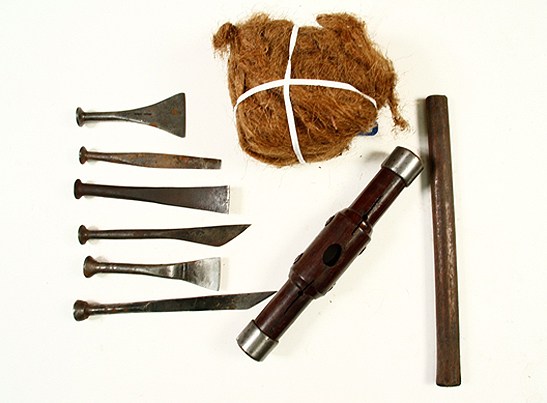
What on earth is caulking? This is just one of many ‘What the…?’ moments I had when I first delved into the world of shipwright’s tools as part of my internship experience at the Australian National Maritime Museum. I’m a student at The University of Sydney working toward my Master of Museum Studies degree and with fellow intern Dimity Kasz – for our recent internship project at the museum we have registered the Lake collection of shipwright’s tools. This collection of several hundred tools were owned by father and son Alfred and Bernard Lake date from around 1890 to 1950.
Registering a collection involves researching the objects and their context, cataloguing them and recording details such as general description, dimensions, markings and interesting features and assigning each object with a unique identifying number and collection record. To our surprise, we found this to be a very interesting set of tools, many of which were hand-made, passed from father to son.
But what exactly is caulking?
Caulking refers to the method used to make wooden decks on ships watertight, and involves some really nifty tools. Strands of oakum, a fibrous material derived from jute, are driven between the wedge-shaped joins between the timbers and then covered with tar or pitch to make the deck watertight. This process took a lot of skill – not enough oakum and water could get between the cracks, too much and the planks could split apart.

Typical caulking tools – irons, a mallet head and handle, and a ball of oakum – from the Lake collection. ANMM Collection
My favourite tool from the collection has to be the caulking mallet. A shipwright’s caulking mallet had a unique design; it featured a distinctive longitudinal slot in the head of the mallet to give some ‘springiness’ to the hard wood, usually oak, which would reduce jarring on the user’s wrist.
Shipwrights would take great pride in their mallets, and would tell you that a good mallet, property cared for, would not only make work easier, but would be a pleasure to listen to. Shipwrights would even adjust the slots to try and get a better sound from the mallet than that of their workmates!

The unique longitudinal slots in the head of the mallet that made it ‘sing’. ANMM Collection
An English shipwright recalled…
‘The old shipwrights liked to hear the mallet sing; the slots caused the singing. All these things were done for a good reason – If several men are caulking on deck together and they used ordinary mallets, they would deafen one another.’
(Dictionary of Woodworking Tools, R. A Salman, 1989 ).
Another shipwright recounted the unique sound of the shipwright’s mallet…
‘The slots make the mallets whistle, like birds. You can stand a quarter mile away and if you hear them whistle, you know the caulking is being done right.’
(Dictionary of Woodworking Tools, R. A Salman, 1989 ).

Caulking the hull of HMB Endeavour replica in recent dry-dock visit.
What do these musical mallets drive? Caulking irons of course! Caulking irons are chisel-like tools with flared blades that had edges that were sharp, blunt or made with grooves known as creases. There are a number of shapes and styles of caulking iron – one for opening a seam, one for sinking the oakum deep into the seam which had creases to harden the oakum down, one with a bend to help reach into areas where a normal iron cannot, and a sharp iron to trim and strip away unwanted threads of oakum before the pitch was played out over the top. I could never have imagined that I would want to hear the sound of a shipyard when I started this project, but now I’d love to be able to enjoy the whistling songs of those musical mallets!
Courtney Eckler
Registration Intern
